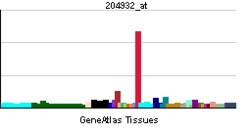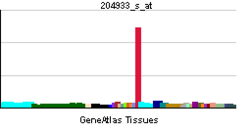- Osteoprotegerin
-
Osteoprotegerin (OPG), also known as osteoclastogenesis inhibitory factor (OCIF), or tumor necrosis factor receptor superfamily member 11B (TNFRSF11B), is a protein that in humans is encoded by the TNFRSF11B gene.[1] Osteoprotegerin is a cytokine receptor, and a member of the tumor necrosis factor (TNF) receptor superfamily.
Contents
Structure
Osteoprotegerin is a basic glycoprotein comprising 401 amino acid residues arranged into 7 structural domains. It is found as either a 60-kDa monomer or 120-kDa dimer linked by disulfide bonds.[2]
Function
Osteoprotegerin is a decoy receptor for the receptor activator of nuclear factor kappa B ligand (RANKL). By binding RANKL, OPG inhibits nuclear kappa B (NF-κB) which is a central and rapid acting transcription factor for immune-related genes, and a key regulator of inflammation, innate immunity, and cell survival and differentiation.[3] Osteoprotegerin levels are influenced by voltage-dependent calcium channels Cav1.2.[4] OPG can reduce the production of osteoclasts, by inhibiting the differentiation of osteoclast precursors (osteoclasts are related to monocytes/macrophages and are derived from granulocyte/macrophage-forming colony units (CFU-GM)) into osteoclasts and also regulates the resorption of osteoclasts in vitro and in vivo. OPG binding to RANKL on osteoblast/stromal cells, blocks the RANKL-RANK ligand interaction between osteoblast/stromal cells and osteoclast precursors. This has the effect of inhibiting the differentiation of the osteoclast precursor into a mature osteoclast.
Regulation and therapeutic applications
Osteoprotegerin production is stimulated in vivo by the female sex hormone estrogen,[5] as well as the osteoporosis drug, strontium ranelate. Denosumab is a pharmacologic agent that in essence acts like osteoprotegerin as both act as decoy receptors for osteoblastic RANKL.
Recombinant human osteoprotegerin specifically acts on bone, increasing bone mineral density and bone volume. Space shuttle flight STS-108 in 2001 tested the effects of osteoprotegerin on mice in microgravity, finding that it did prevent increase in resorption and maintained mineralization.[6][7] Osteoprotegerin has been used experimentally to decrease bone resorption in women with postmenopausal osteoporosis and in patients with lytic bone metastases.
Clinical significance
Elevated OPG levels has been reported in heart diseases[8] and in severe mental disorders.[9]
References
- ^ Simonet WS, Lacey DL, Dunstan CR, Kelley M, Chang MS, Lüthy R, Nguyen HQ, Wooden S, Bennett L, Boone T, Shimamoto G, DeRose M, Elliott R, Colombero A, Tan HL, Trail G, Sullivan J, Davy E, Bucay N, Renshaw-Gegg L, Hughes TM, Hill D, Pattison W, Campbell P, Sander S, Van G, Tarpley J, Derby P, Lee R, Boyle WJ (April 1997). "Osteoprotegerin: a novel secreted protein involved in the regulation of bone density". Cell 89 (2): 309–19. doi:10.1016/S0092-8674(00)80209-3. PMID 9108485.
- ^ Schoppet M, Preissner KT, Hofbauer LC (April 2002). "RANK ligand and osteoprotegerin: paracrine regulators of bone metabolism and vascular function". Arterioscler. Thromb. Vasc. Biol. 22 (4): 549–53. doi:10.1161/01.ATV.0000012303.37971.DA. PMID 11950689.
- ^ Krakauer T (2008). "Nuclear factor-kappaB: fine-tuning a central integrator of diverse biologic stimuli". Int. Rev. Immunol. 27 (5): 286–92. doi:10.1080/08830180802317957. PMID 18853340.
- ^ PMID14525906
- ^ Khosla S (December 2001). "Minireview: the OPG/RANKL/RANK system". Endocrinology 142 (12): 5050–5. doi:10.1210/en.142.12.5050. PMID 11713196.
- ^ "Commercial Biomedical Testing Module: Effects of Osteoprotegerin on Bone Maintenance in Microgravity (CBTM)". U.S. National Aeronautics and Space Administration (NASA). http://www.nasa.gov/mission_pages/station/science/experiments/CBTM.html.
- ^ Bateman TA, Countryman S (April 2002). "Osteoprotegerin and bone loss associated with spaceflight". Drug Discov. Today 7 (8): 456–7. doi:10.1016/S1359-6446(02)02260-2. PMID 11965392.
- ^ Venuraju SM, Yerramasu A, Corder R, Lahiri A (May 2010). "Osteoprotegerin as a predictor of coronary artery disease and cardiovascular mortality and morbidity". J. Am. Coll. Cardiol. 55 (19): 2049–61. doi:10.1016/j.jacc.2010.03.013. PMID 20447527.
- ^ Hope S, Melle I, Aukrust P, Agartz I, Lorentzen S, Steen NE, Djurovic S, Ueland T, Andreassen OA (September 2010). "Osteoprotegerin levels in patients with severe mental disorders". J Psychiatry Neurosci 35 (5): 304–10. doi:10.1503/jpn.090088. PMC 2928283. PMID 20569643. http://www.pubmedcentral.nih.gov/articlerender.fcgi?tool=pmcentrez&artid=2928283.
Further reading
- Blázquez-Medela AM, López-Novoa JM, Martínez-Salgado C.Osteoprotegerin and diabetes-associated pathologies.Curr Mol Med. 2011 Jul 1;11(5):401-16. Review.PMID: 21568931
- Hofbauer LC, Neubauer A, Heufelder AE (2001). "Receptor activator of nuclear factor-kappaB ligand and osteoprotegerin: potential implications for the pathogenesis and treatment of malignant bone diseases". Cancer 92 (3): 460–70. doi:10.1002/1097-0142(20010801)92:3<460::AID-CNCR1344>3.0.CO;2-D. PMID 11505389.
- Buckley KA, Fraser WD (2003). "Receptor activator for nuclear factor kappaB ligand and osteoprotegerin: regulators of bone physiology and immune responses/potential therapeutic agents and biochemical markers". Ann. Clin. Biochem. 39 (Pt 6): 551–6. doi:10.1258/000456302760413324. PMID 12564836.
- Kimberley FC, Screaton GR (2005). "Following a TRAIL: update on a ligand and its five receptors". Cell Res. 14 (5): 359–72. doi:10.1038/sj.cr.7290236. PMID 15538968.
- Collin-Osdoby P (2005). "Regulation of vascular calcification by osteoclast regulatory factors RANKL and osteoprotegerin". Circ. Res. 95 (11): 1046–57. doi:10.1161/01.RES.0000149165.99974.12. PMID 15564564.
- Whyte MP, Mumm S (2005). "Heritable disorders of the RANKL/OPG/RANK signaling pathway". Journal of musculoskeletal & neuronal interactions 4 (3): 254–67. PMID 15615493.
- Anandarajah AP, Schwarz EM (2006). "Anti-RANKL therapy for inflammatory bone disorders: Mechanisms and potential clinical applications". J. Cell. Biochem. 97 (2): 226–32. doi:10.1002/jcb.20674. PMID 16240334.
- Baud'huin M, Duplomb L, Ruiz Velasco C, et al. (2007). "Key roles of the OPG-RANK-RANKL system in bone oncology". Expert Rev Anticancer Ther 7 (2): 221–32. doi:10.1586/14737140.7.2.221. PMID 17288531.
- Boyce BF, Xing L (2007). "Biology of RANK, RANKL, and osteoprotegerin". Arthritis Res. Ther. 9 Suppl 1 (Suppl 1): S1. doi:10.1186/ar2165. PMC 1924516. PMID 17634140. http://www.pubmedcentral.nih.gov/articlerender.fcgi?tool=pmcentrez&artid=1924516.
- Maruyama K, Sugano S (1994). "Oligo-capping: a simple method to replace the cap structure of eukaryotic mRNAs with oligoribonucleotides". Gene 138 (1–2): 171–4. doi:10.1016/0378-1119(94)90802-8. PMID 8125298.
- Tsuda E, Goto M, Mochizuki S, et al. (1997). "Isolation of a novel cytokine from human fibroblasts that specifically inhibits osteoclastogenesis". Biochem. Biophys. Res. Commun. 234 (1): 137–42. doi:10.1006/bbrc.1997.6603. PMID 9168977.
- Suzuki Y, Yoshitomo-Nakagawa K, Maruyama K, et al. (1997). "Construction and characterization of a full length-enriched and a 5'-end-enriched cDNA library". Gene 200 (1–2): 149–56. doi:10.1016/S0378-1119(97)00411-3. PMID 9373149.
- Tan KB, Harrop J, Reddy M, et al. (1998). "Characterization of a novel TNF-like ligand and recently described TNF ligand and TNF receptor superfamily genes and their constitutive and inducible expression in hematopoietic and non-hematopoietic cells". Gene 204 (1–2): 35–46. doi:10.1016/S0378-1119(97)00509-X. PMID 9434163.
- Yamaguchi K, Kinosaki M, Goto M, et al. (1998). "Characterization of structural domains of human osteoclastogenesis inhibitory factor". J. Biol. Chem. 273 (9): 5117–23. doi:10.1074/jbc.273.9.5117. PMID 9478964.
- Yasuda H, Shima N, Nakagawa N, et al. (1998). "Identity of osteoclastogenesis inhibitory factor (OCIF) and osteoprotegerin (OPG): a mechanism by which OPG/OCIF inhibits osteoclastogenesis in vitro". Endocrinology 139 (3): 1329–37. doi:10.1210/en.139.3.1329. PMID 9492069.
- Yasuda H, Shima N, Nakagawa N, et al. (1998). "Osteoclast differentiation factor is a ligand for osteoprotegerin/osteoclastogenesis-inhibitory factor and is identical to TRANCE/RANKL". Proc. Natl. Acad. Sci. U.S.A. 95 (7): 3597–602. doi:10.1073/pnas.95.7.3597. PMC 19881. PMID 9520411. http://www.pubmedcentral.nih.gov/articlerender.fcgi?tool=pmcentrez&artid=19881.
- Tomoyasu A, Goto M, Fujise N, et al. (1998). "Characterization of monomeric and homodimeric forms of osteoclastogenesis inhibitory factor". Biochem. Biophys. Res. Commun. 245 (2): 382–7. doi:10.1006/bbrc.1998.8443. PMID 9571159.
- Bucay N, Sarosi I, Dunstan CR, et al. (1998). "osteoprotegerin-deficient mice develop early onset osteoporosis and arterial calcification". Genes Dev. 12 (9): 1260–8. doi:10.1101/gad.12.9.1260. PMC 316769. PMID 9573043. http://www.pubmedcentral.nih.gov/articlerender.fcgi?tool=pmcentrez&artid=316769.
- Emery JG, McDonnell P, Burke MB, et al. (1998). "Osteoprotegerin is a receptor for the cytotoxic ligand TRAIL". J. Biol. Chem. 273 (23): 14363–7. doi:10.1074/jbc.273.23.14363. PMID 9603945.
- Morinaga T, Nakagawa N, Yasuda H, et al. (1998). "Cloning and characterization of the gene encoding human osteoprotegerin/osteoclastogenesis-inhibitory factor". Eur. J. Biochem. 254 (3): 685–91. doi:10.1046/j.1432-1327.1998.2540685.x. PMID 9688283.
- Blázquez-Medela AM, López-Novoa JM, Martínez-Salgado C (July 2011). "Osteoprotegerin and diabetes-associated pathologies". Curr. Mol. Med. 11 (5): 401–16. PMID 21568931.
External links
Cytokine receptors Chemokine receptor
(GPCRs)OtherTNF receptor 1-1011-2021-25JAK-STAT OtherIg superfamily IL-17 family S/T B trdu: iter (nrpl/grfl/cytl/horl), csrc (lgic, enzr, gprc, igsr, intg, nrpr/grfr/cytr), itra (adap, gbpr, mapk), calc, lipd; path (hedp, wntp, tgfp+mapp, notp, jakp, fsap, hipp, tlrp) Categories:- Human proteins
- Cytokine receptors
Wikimedia Foundation. 2010.


